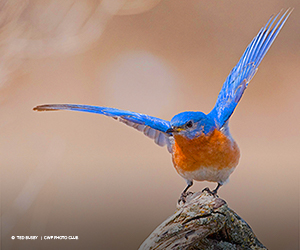
SCIENTIFIC NAME
Sialia currucoides, Sialia sialis, Sialia Mexicana
DESCRIPTION
Canada has three species of bluebirds. They are in the Thrush family, the same family as the American Robin. Bluebirds are a little smaller than our robins, averaging about 7 inches in length and 13-14 inches in width. All bluebirds have blue heads, wings, backs and tails, which gives them their name. All species also have a black bill, legs and eyes. The differences between species come mainly from the colouring of the throat, breast and belly. The male Mountain Bluebird is mainly blue with a pale blue breast and white belly. The male Western Bluebird is a darker blue with orange-red on the upper and side portions of its chest and dull blue-white on the lower middle portion. The male Eastern Bluebird is similar to the Western Bluebird, but the orange also covers its throat and the front sides of its neck. Another distinction is that its white belly is brighter. The females and juveniles of these species have similar colouring to the adult males but a much paler version.
RANGE
Mountain Bluebird – B.C., A.B., S.K., southwest M.B., Y.T., very southeast corner of N.T. Rare occurrences eastward in O.N., Q.C., N.B. and N.S. Western Bluebird – southern B.C., swab Eastern Bluebird – southeast S.K., M.B., O.N., Q.C., N.B., N.S. Rare occurrences in southwest S.K. and A.B.
HABITAT
Mountain Bluebird – Valleys and prairie habitat as well as higher elevations and farmland Western and Eastern Bluebird – Edge habitat, farmland and orchards at low elevations
DIET
All bluebirds eat a mix of insects, fruit and the seeds of plants considered ‘weeds.’
BEHAVIOUR
undefinedPRIMARY ECOSYSTEM ROLES
Bluebirds help keep insect species in balance.
